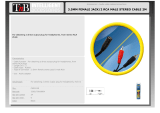8
Hint: When connecting to the fixed audio outputs of a VCR, remember that for the
wireless system to work, the VCR must be active. In other words, turn the TV on to
the channel you would normally use to watch a videotape (channel 3 or 4), turn the
VCR on, then press the TV/VCR button on your VCR remote control one time to
make the VCR the controlling piece of equipment. At this point, whatever channel is
showing on the tuner for the VCR should be the channel playing on the TV. Change
channels on the VCR. This configuration gives independent volume control through
the TV (using the TV remote control) and at the headphones. This allows others in
the room to listen to TV at volume levels they find comfortable, and you to listen
through the headphones at volume levels you find acceptable.
Hint: If your VCR (or other RCA-type audio source you are connecting to) is mono (a
single audio output), you need to acquire another RCA “Y” Cable. It differs from the
“Y” Cable Adapter included in this kit. It will have a single male RCA plug and 2
female RCA jacks. Connect the dual RCA cables from the transmitter to the 2 female
RCA jacks on the “Y” cable, then connect the single male RCA plug of the “Y“cable to
the single audio output of the VCR.
About Variable-Level Outputs
A variable-level output, such as a headphone jack or certain RCA-type outputs, pro-
vides an audio signal to the transmitter that changes in relation to volume adjust-
ments on the audio source. As the volume of the audio source goes up and down, so
too does the audio signal strength sent to the transmitter. This can affect the quality
of sound you hear at the headphones, and may require increasing or decreasing the
volume level of the audio source to achieve a suitably strong audio signal for use
with the AW770 system. For more information on how to use the AW770 with vari-
able outputs, see the following section, “About Using the Headphones with a TV”.
Hint: On most bookshelf-type or compact stereo systems, inserting a headphone plug
into the headphone jack results in automatic cutoff of the stereo system speakers.
Hint: Most TVs, regardless of age or price, have variable outputs. If you are unsure
which, if any of your outputs is fixed, refer to the TV instruction manual. Some TVs
have outputs that can switch between variable and fixed. Refer to the TV instruc-
tion manual. When given a choice, fixed is always recommended.
About Using the Headphones with a TV
Wireless headphones are frequently used so that one person with hearing difficulty
can listen to TV at a sufficiently high volume level while others in the room listen to
the TV at normal volume levels.
Hint: If you want to use the headphones to listen to TV independent of the volume
from the TV, and your TV has variable outputs, it is recommended you connect the
transmitter to the VCR, as described in the second HINT under “About Fixed-Level
Outputs.” This configuration gives you a fixed-level output for independent volume
control at the headphones, while others in the room can turn the TV volume up and
down (even all the way down) without interfering with what you hear.
















